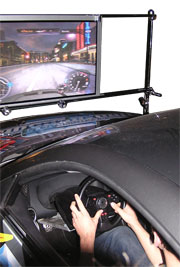- Introduction to gaming and childhood development
- Statistics on gaming and children
- Benefits of gaming
- Drawbacks and risks of excessive gaming
- Reduced socialisation
- Behavioural problems in adolescence
- Increased risk of developing ADHD
- Addictive nature of gaming, pathological gaming
- Poorer performance at school
- Altered autonomic activity – physiological adaptation
- Reduced sleep and altered sleep patterns
- Subsequent health conditions
- Cognitive function
- Eye strain and injury
- Gaming-induced seizures
- Tips for managing gaming exposure
Introduction to gaming and childhood development
In an increasingly screen-based society, the potential harmful effects of gaming on lifestyle and behaviour in children of all ages need to be carefully monitored. In recent years, there has been an explosion in the number of games, both console games and online games. The effects of these gaming activities on childhood development and the subsequent adulthood consequences remain largely unknown.
Statistics

On average, children aged 2–5 years spend 32 hours a week in front of a screen (of this, about 1 hour is spent on consoles) and children aged 6–11 years spend 28 hours a week in front of a screen (of this, about 2.5 hours is spent on consoles).
Benefits of gaming
There may be some limited benefits of gaming over traditional screen activities, such as watching television or DVDs.
Increased energy expenditure of activity-promoting games
The first benefit is that energy expenditure has been shown to increase when children or adults participate in activity-promoting games and systems. Energy expenditure and physical activity were monitored in children and adults at rest, when standing, when sitting and watching television, when sitting and playing a traditional sedentary game, and when playing an activity-promoting video game (e.g. Nintendo® WiiTM boxing). Energy expenditure increased significantly over all other activities when children and adults played the boxing game.
A similar study also reported the energy-expenditure benefits of activity-promoting video games in 10–13-year-old boys and girls. Compared with watching television, energy expenditure while gaming or walking increased 2- to 3-fold. High rates of energy expenditure, heart rate, and perceived exertion were elicited from playing Nintendo® WiiTM boxing, Dance Dance Revolution level 2, or walking at 5.7 km/h.

Improved eyesight and hand-eye coordination
Recent studies have shown a positive effect of action gaming on eyesight, with video game players having an enhanced ability to discriminate between shades of colour, improved visual attention, faster reaction times and improved short-term memory skills compared to non-video game players.
The clearer vision reported by players of action video gamers has led to the suggestion that video games could be used to train adults to improve their vision and also as a form of rehabilitation. Video games can be used as a form of rehabilitation for people with vision loss due to a problem in their brain, such as the elderly, people with amblyopia, and people who have had a stroke. Amblyopia is a developmental vision disorder characterised by spatial vision abnormalities, including reduced contrast sensitivity and abnormal contour. It has long been thought that these sight problems are irreversible after childhood, but recent studies have shown that this is not the case.
Drawbacks and risks of excessive gaming
The effects of video gaming on children and adolescents are not well documented as gaming is a relatively recent addition to media, although some of the adverse effects are likely to be similar to those reported for excessive television viewing. These include: increased risk of ADHD, obesity, asthma, reduced performance at school and altered cognitive function.
 |
For more information, seeTelevision and Childhood Development. |

Behavioural problems in adolescence
A study of adolescents (10–14 years) showed that individuals with problem behaviour, such as aggression and delinquency, engaged in more online gaming, internet communication and playing first-person shooters. Online role-playing games were predictive of internalising problem behaviour such as withdrawal and anxiety. Another report found an association between excessive gaming and aggressive behaviour.
Increased risk of developing ADHD
As with television viewing, there is an association between the amount of time spent gaming and the risk of developing attention deficit hyperactivity disorder (ADHD). A study found that adolescents who spent more than 1 hour a day playing console or computer games have more, or more intense, symptoms of ADHD and inattention. In a similar report, it was shown that exposure to all media types (including gaming) was associated with greater attention problems.
 |
For more information on the symptoms of ADHD and its medications, and some useful tools and animations, see Childhood ADHD. |
Addictive nature of gaming, pathological gaming
In a study that separated gamers into two groups – those highly engaged in gaming, and those meeting the criteria for addiction – addiction was associated with reduced scholastic performance. It has been found that ~12% of gamers fulfilled the diagnostic criteria required for addiction concerning their gaming behaviour, referred to as pathological gaming. These individuals found it easier to meet people online, had fewer friends in real life and showed features of cravings and withdrawal associated with their gaming activities.

Altered autonomic activity – physiological adaptation
12–15-year-olds who played a violent video game, compared with those who played a non-violent video game, exhibited significant alterations in some features of heart rate. These changes continued into the night following violent game playing. This study indicates that violent gaming induces different autonomic responses compared to non-violent gaming, during play and into the following night. This suggests that there are different emotional responses to violence.
Reduced sleep and altered sleep patterns
Children who have a gaming computer in their bedrooms spend significantly less time in bed and go to bed significantly later on weekdays. Gaming use in general has only a mild effect on adolescent sleep.
 |
For more information on good sleep practices, see Sleep Hygiene. |
As with television viewing, online and console gaming is by and large a sedentary activity, and as such is associated with an elevated BMI. Furthermore, the explosion of advertisements within online games (referred to as “advergaming“) for high-calorie food and beverages further exacerbates the health problems associated with gaming.
In one isolated case, a 40-year-old male experienced rhabdomyolysis (a potentially life-threatening condition due to extreme muscle breakdown). In this case, the strenuous use of upper arm and other muscles with prolonged computer gaming contributed to the excessive muscle damage and breakdown and subsequent kidney failure.
Cognitive development (thought and information processing)

In addition to increased risk-taking with excessive gaming, gaming is also associated with behavioural changes, including:
- Increased anxiety;
- Aggression;
- Withdrawal and delinquency;
- A lack of empathy; and
- Desensitisation to violence and people’s emotions.
Screen viewing is associated with reduced rates of blinking, and subsequently dry and strained eyes.
 |
For more information on eye strain and how to prevent it, see Office Ergonomics: Preventing Eye Strain. |
Studies have shown that some individuals experience epileptic seizures due to screen viewing, including console and computer gaming.
The brains of people who experience electronic screen game-induced seizures show an abnormal visual sensitivity to pattern-stimulation tests on cathode ray tubes (CRTs). Thus photosensitivity is an important contributor to the development of screen-induced seizures.
In another study, it was shown that photosensitivity was also an important contributing factor for people playing multiplayer online role-playing games (MORPGs) who experience seizures, as was behavioural and higher mental activities. The seizures associated with MORPGs showed different characteristics to those brought on with ordinary video game use.
Tips for managing gaming exposure

- Educate yourself about the gaming activities undertaken by your child;
- Set up the computer in a common area of the house, not the bedroom;
- If necessary, negotiate time limits for gaming;
- Assess how gaming is affecting your child, in terms of social groups, school performance, other hobbies and interests, and so on;
- Try to think back to when you were a child or teenager and how your parents were concerned about certain emerging issues;
- Focus on resolving a problem rather than the gaming (e.g. if your child is tired, then devise ways for them to get more sleep); and
- If you are concerned that your child may be addicted to gaming, speak with your doctor for professional help.
More information
 |
For more information on technology and its impact on health, childhood development and office injuries, as well as some useful videos, see Technology and Health. |
References
- McDonagh P. TV viewing among kids at an eight-year high [online]. New York: Nielsen; 26 October 2009 [cited 25 August 2010]. Available from: URL link
- Mellecker RR, McManus AM. Energy expenditure and cardiovascular responses to seated and active gaming in children. Arch Pediatr Adolesc Med. 2008;162(9):886-91. [Abstract | Full text]
- Pate RR. Physically active video gaming: An effective strategy for obesity prevention? Arch Pediatr Adolesc Med. 2008;162(9):895-6. [Abstract]
- Daley AJ. Can exergaming contribute to improving physical activity levels and health outcomes in children? Pediatrics. 2009;124(2):763-71. [Abstract | Full text]
- Lanningham-Foster L, Foster RC, McCrady SK, et al. Activity-promoting video games and increased energy expenditure. J Pediatr. 2009;154(6):819-23. [Abstract | Full text]
- Graf DL, Pratt LV, Hester CN, Short KR. Playing active video games increases energy expenditure in children. Pediatrics. 2009;124(2):534-40. [Abstract | Full text]
- Goodman D, Bradley NL, Paras B, et al. Video gaming promotes concussion knowledge acquisition in youth hockey players. J Adolesc. 2006;29(3):351-60. [Abstract]
- Li R, Polat U, Makous W, Bavelier D. Enhancing the contrast sensitivity function through action video game training. Nat Neurosci. 2009;12(5):549-51. [Abstract | Full text]
- Dye MW, Bavelier D. Differential development of visual attention skills in school-age children. Vision Res. 2010;50(4):452-9. [Abstract]
- Dye MW, Green CS, Bavelier D. Increasing speed of processing with action video games. Curr Dir Psychol Sci. 2009;18(6):321-6. [Abstract | Full text]
- Green CS, Bavelier D. Enumeration versus multiple object tracking: The case of action video game players. Cognition. 2006;101(1):217-45. [Abstract | Full text]
- Achtman RL, Green CS, Bavelier D. Video games as a tool to train visual skills. Restor Neurol Neurosci. 2008;26(4-5):435-46. [Abstract | Full text]
- Hussain Z, Griffiths MD. Gender swapping and socializing in cyberspace: an exploratory study. Cyberpsychol Behav. 2008 Feb;11(1):47-53. [Abstract]
- Porter G, Starcevic V, Berle D, Fenech P. Recognizing problem video game use. Aust N Z J Psychiatry. 2010 Feb;44(2):120-8. [Abstract]
- Richards R, McGee R, Williams SM, Welch D, Hancox RJ. Adolescent screen time and attachment to parents and peers. Arch Pediatr Adolesc Med. 2010 Mar;164(3):258-62. [Abstract]
- Holtz P, Appel M. Internet use and video gaming predict problem behavior in early adolescence. J Adolesc. 2010 Mar 18. [Abstract]
- Grusser SM, Thalemann R, Griffiths MD. Excessive computer game playing: evidence for addiction and aggression? Cyberpsychol Behav. 2007 Apr;10(2):290-2. [Abstract]
- Chan PA, Rabinowitz T. A cross-sectional analysis of video games and attention deficit hyperactivity disorder symptoms in adolescents. Ann Gen Psychiatry. 2006;5:16. Available from: [Abstract]
- Swing EL, Gentile DA, Anderson CA, Walsh DA. Television and video game exposure and the development of attention problems. Pediatrics. 2010 Aug;126(2):214-21. [Fulltext]
- Skoric MM, Teo LL, Neo RL. Children and video games: addiction, engagement, and scholastic achievement. Cyberpsychol Behav. 2009 Oct;12(5):567-72. [Abstract]
- Ivarsson M, Anderson M, Akerstedt T, Lindblad F. Playing a violent television game affects heart rate variability. Acta Paediatr. 2009 Jan;98(1):166-72. [Fulltext]
- Van den Bulck J. Television viewing, computer game playing, and internet use and self-reported time to bed and time out of bed in secondary-school children. Sleep. 2004 Feb 1;27(1):101-4. [Abstract]
- Jain A. Temptations in cyberspace: new battlefields in childhood obesity. Health Aff (Millwood). 2010 Mar-Apr;29(3):425-9. [Abstract]
- Vandewater EA, Shim MS, Caplovitz AG. Linking obesity and activity level with children’s television and video game use. J Adolesc. 2004 Feb;27(1):71-85. [Abstract]
- Song SH, Lee DW, Lee SB, Kwak IS. Rhabdomyolysis caused by strenuous computer gaming. Nephrol Dial Transplanthttp. 2007 Apr;22(4):1263-4. [Abstract]
- Fischer P, Kubitzki J, Guter S, Frey D. Virtual driving and risk taking: do racing games increase risk-taking cognitions, affect, and behaviors? J Exp Psychol Appl. 2007 Mar;13(1):22-31. [Abstract]
- Acosta MC, Gallar J, Belmonte C. The influence of eye solutions on blinking and ocular comfort at rest and during work at video display terminals. Exp Eye Res. 1999 Jun;68(6):663-9. [Abstract]
- Tsubota K, Miyake M, Matsumoto Y, Shintani M. Visual protective sheet can increase blink rate while playing a hand-held video game. Am J Ophthalmol. 2002 May;133(5):704-5. [Abstract]
- Himebaugh NL, Begley CG, Bradley A, Wilkinson JA. Blinking and tear break-up during four visual tasks. Optom Vis Sci. 2009 Feb;86(2):E106-14. [Abstract]
- Chuang YC. Massively multiplayer online role-playing game-induced seizures: a neglected health problem in Internet addiction. Cyberpsychol Behav. 2006 Aug;9(4):451-6. [Abstract]
- Funatsuka M, Fujita M, Shirakawa S, Oguni H, Osawa M. Study on photo-pattern sensitivity in patients with electronic screen game-induced seizures (ESGS): effects of spatial resolution, brightness, and pattern movement. Epilepsia. 2001 Sep;42(9):1185-97. [Abstract]
- Singh R, Bhalla A, Lehl SS, Sachdev A. Video game epilepsy. Neurol India. 2001 Dec;49(4):411-2. [Abstract]
- Shoja MM, Tubbs RS, Malekian A, Jafari Rouhi AH, Barzgar M, Oakes WJ. Video game epilepsy in the twentieth century: a review. Childs Nerv Syst. 2007 Mar;23(3):265-7. [Abstract]
- New South Wales Government. Game over: knowing when to stop. Information for parents about managing online computer gaming. 2010. [Fulltext]
All content and media on the HealthEngine Blog is created and published online for informational purposes only. It is not intended to be a substitute for professional medical advice and should not be relied on as health or personal advice. Always seek the guidance of your doctor or other qualified health professional with any questions you may have regarding your health or a medical condition. Never disregard the advice of a medical professional, or delay in seeking it because of something you have read on this Website. If you think you may have a medical emergency, call your doctor, go to the nearest hospital emergency department, or call the emergency services immediately.







